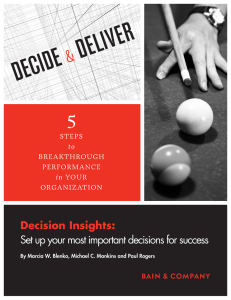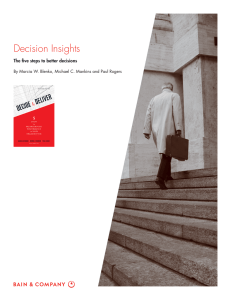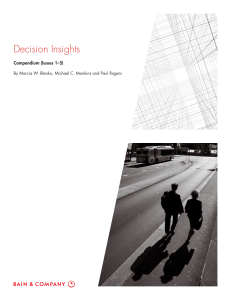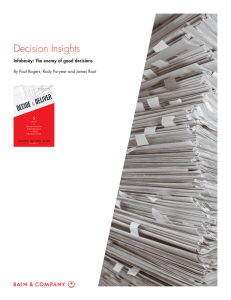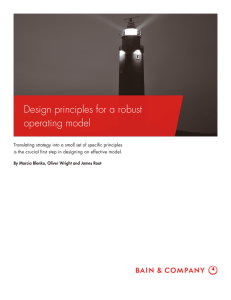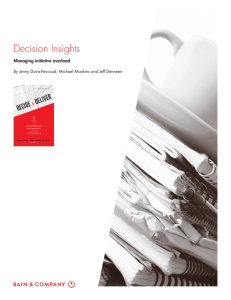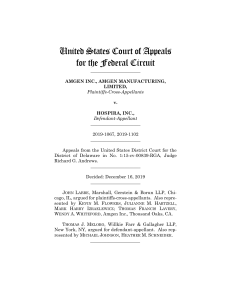Decision Insights: Score your organization
advertisement
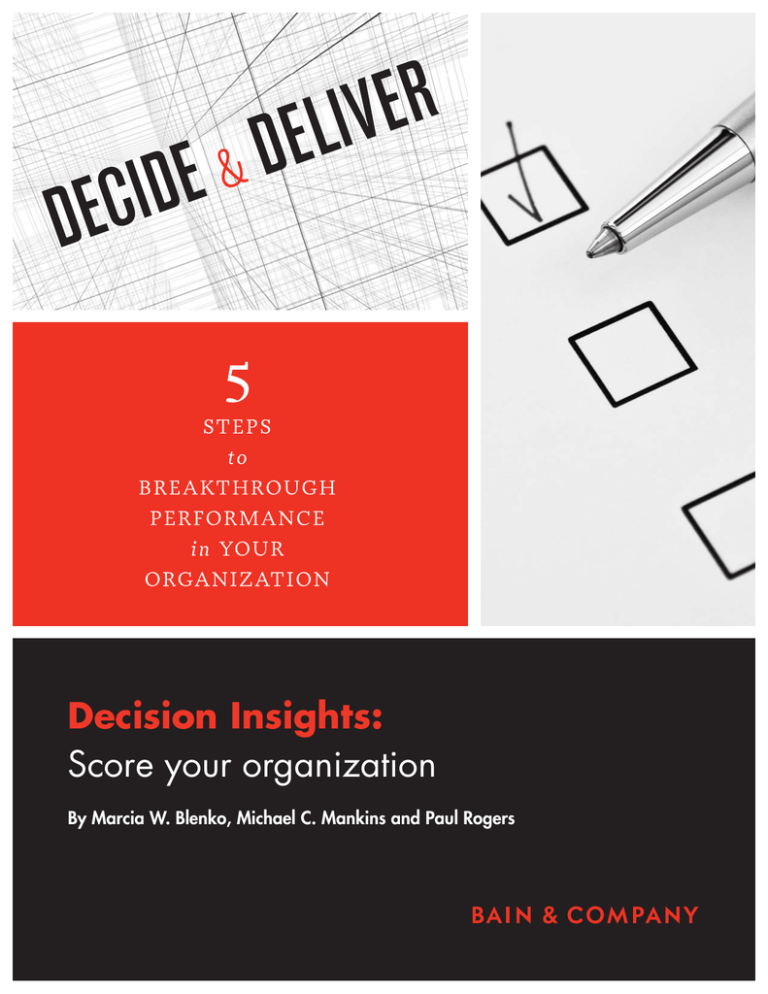
Decision Insights: Score your organization By Marcia W. Blenko, Michael C. Mankins and Paul Rogers Marcia W. Blenko (marcia.blenko@bain.com) leads Bain’s Global Organization practice. She has extensive experience in decision effectiveness and organization design across a range of sectors. Marcia has authored numerous articles on organization, decision effectiveness, and leadership and often speaks on these topics. Her writings have appeared in Harvard Business Review, Financial Times, Wall Street Journal, Economic Times, European Business Journal, Harvard Management Update, and the World Economic Forum’s Global Agenda. She is also a contributing author of Winning in Turbulence (Harvard Business Press, 2009). Marcia is a partner in Bain’s Boston office. Michael C. Mankins (michael.mankins@bain.com) leads Bain’s Organization practice in the Americas and is a key member of Bain’s Strategy practice. He advises business leaders on the strategic and organizational initiatives required to drive performance and long-term value. Michael’s writings have appeared in Harvard Business Review, Wall Street Journal, Financial Times, Harvard Management Update, Journal of Business Strategy, Directors & Boards, Chief Executive, and other publications. He has been a featured speaker at numerous conferences and is coauthor of The Value Imperative: Managing for Superior Shareholder Returns (Free Press, 1994). In 2006, Consulting Magazine named Michael one of the year’s “top 25 most influential consultants.” Michael is a partner in Bain’s San Francisco office. Paul Rogers (paul.rogers@bain.com) is the managing partner for Bain’s London office and previously led Bain’s Global Organization practice. Paul’s organizational experience spans comprehensive transformation, decision effectiveness, culture change, talent management, front-line employee loyalty, overhead optimization, and change management. Paul has authored numerous articles on organizational effectiveness and successful change in Harvard Business Review, European Business Forum, Business Strategy Series, Financial Times, and others, and he regularly speaks on these topics. Copyright © 2010 Bain & Company, Inc. All rights reserved. Content: Editorial team Layout: Global Design Decision Insights: Score your organization Hospira, a $3.6 billion specialty medical device and pharmaceutical company, had developed an ambitious plan for growth and for more than $100 million in cost savings. Executing the plan would put the company in its industry’s top quartile, where CEO Chris Begley felt it belonged. But was Hospira’s organization up to the challenge? Begley wasn’t sure. Many decisions in every part of the company seemed to take longer than they should. Hospira produced hundreds of marketing brochures every year, for instance, and the process for each was painfully slow. Drafts were passed along in manila folders. People added comments in longhand. Nobody really knew who had the final say. If the company couldn’t speed up its metabolism on everyday issues like that, could it really hope to enter the top ranks? Decisions are the key to organizational per1 formance. You may have a great strategic plan, plenty of resources and a deep bench of talent. But if your company can’t make and execute decisions well, nothing else matters. CEOs such as Chris Begley know this, which is why so many companies are focusing on improving their decision abilities. The first steps in this process, not surprisingly, are (1) a rigorous, fact-based assessment of your organization’s decision effectiveness and (2) an equally thorough review of the organizational strengths and weaknesses that contribute to your decision score. Assessing decision effectiveness: What are the trouble spots? In our view, decision effectiveness has four distinct components: • Quality. One is decision quality—whether a company makes good decisions more often than not. The best gauge of quality is whether in retrospect people believe they chose the right course of action. • Speed. How quickly an organization moves can be as important as how good its decisions are. What counts most isn’t absolute speed, which will vary according to the business you’re in and the kind of decision you’re making, but speed relative to competitors. • Yield. Decision yield, or how well a company turns its decisions into action, is always critical to performance. Poor execution of a decision—or a complete failure to execute, as sometimes happens—naturally undermines any virtues the decision itself might have had. • Effort. Effort is the time, trouble and sheer emotional energy it takes to make and execute a decision. Decision effectiveness obviously suffers if the effort involved is greater than what the decision merits. But it can also suffer if companies shoot from the hip—that is, if the effort involved is too little. 1 Decision Insights: Score your organization The best way we know to understand how well a company performs on each of these dimensions is to ask the people who work there. For example: In retrospect, how often does your organization make the right decision? Or: How quickly is your organization able to make decisions—faster than competitors, slower or about the same? In making an assessment, we typically survey a broad cross-section of people, including those on or close to the frontline, using questions like these. We then flesh out the survey data (where appropriate) with supplementary information from interviews or group discussions, “X-ray” analyses of decisions that have gone well or badly and so on. 2 When Begley and the team asked themselves whether, from their own experience, the survey results rang true, they had to admit that the scores seemed accurate. They thought back to the marketing brochures, for example. Those decisions, with their many manila-folder stopping points, clearly took too long to wend their way through the system. And the need to reconcile everybody’s handwritten changes meant that effort was definitely higher than it needed to be. But speed and effort weren’t the only issues. The feedback from the sales organization was that the brochures weren’t all that great. The company was taking too much time, devoting too much effort and still not making the best possible decisions. We have also surveyed large numbers of executives from companies around the world, with the objective of creating a diagnostic database for benchmarking purposes (see the box, “What the research shows”). Companies use our data to see how their own performance on each of the four elements measures up against competitors and peers. For Hospira, as for many organizations we have worked with, benchmarking was a wakeup call. Begley began to see that if Hospira could improve on its weakest elements, the company’s whole metabolism would begin to function better. It would accelerate the journey toward top-quartile performance. Hospira, for example, administered a decision survey like ours to the top 300 people in the organization, covering every function and geographical unit. When the results were in, the news wasn’t nearly as good as CEO Begley had hoped. The company’s decision score was below average (around the 40th percentile)— a far cry from the top quartile where Begley and his team aspired to be. Decision quality was fairly good, but speed was below average But Begley also had to ask himself what was holding things back. With the marketing brochures, it was most likely the decision process that needed fixing. But what about all the other decisions that were taking too long or requiring too much effort? Maybe talented, decisive people weren’t in the right positions. Maybe the culture somehow encouraged people to act slowly. Or maybe it was something else entirely. Like any company that has assessed its decision and effort was higher than it should have been. Nearly 80 percent of respondents, regardless of level or function, said decisions took too much effort. Top-level respondents actually rated speed and effort worse than did others in the organization, perhaps because these higher-level leaders were involved in thorny cross-functional or cross-unit decisions. effectiveness and found it wanting, Hospira now had to move on to the second part of the assessment: the organizational system within which decisions happen. Decision Insights: Score your organization Assessing organizational health: Where are the decision barriers? To add depth to a decision survey, we typically also look at the organizational root causes of decision strengths and weaknesses. We have surveyed hundreds of organizations worldwide in this manner as part of our ongoing research, so again we have benchmark diagnostic data. This part of the survey typically offers statements on a broad range of organizational topics and asks respondents to what extent they agree. For example: Individuals are clear on the roles they should play in making and executing critical decisions. People with decision authority have the skills and experience to make good decisions. This kind of research enables executives to identify what is actually helping decision effectiveness and what may be holding it back. which further improvements could be built. Hospira had to ensure that such strengths weren’t undermined by changes to other elements of the organizational system. But the survey also turned up weak spots. People felt that decisions weren’t always made at the right level of the organization, and that the balance between the corporate center and the operating units wasn’t on the mark. They believed that decision processes were flawed: Meetings weren’t used well, interactions around decisions weren’t mapped clearly and so on. Also, the culture needed attention. Not everybody in the organization acted like an owner and made decisions reflecting the company’s best interests. Not everyone brought a customer focus to decisions. There is rarely a direct, one-to-one relationship between specific decision weaknesses, such as poor quality or lack of speed, and a single aspect of the organization. Every organization is a system, and all the elements have to work together to produce great results. Each element of the organizational system not only has to support effective decisions but also reinforce the other elements of the underlying system. In our research, we found that companies with top-quintile decision scores outperformed other companies by about 15 to 20 percent in every single organizational area. And the more elements of organizational health a company scored highly on, the higher its overall decision effectiveness. Thanks to these diagnoses, Hospira redesigned a wide variety of key decisions, and it began reshaping the organization to support and enable continued good decision making and execution. These efforts involved extensive training as well as strong leadership engagement on the organizational changes that would help take Hospira from good to great. At this writing, the company has come far on its journey. One early win was those marketing brochures. A team redesigned the process required to design and approve a set of marketing materials, reducing approval time substantially. Management clarified decision rights, thereby ensuring that people in marketing had a say over the quality of the brochures. The outcome was a smoother process that was faster, consumed less effort and produced brochures attuned to customer needs as well as regulatory requirements. Hospira’s organizational survey revealed significant strengths. The company had good leadership, for instance, and a strong talent pipeline. These were important findings, attributes on Hospira has made similar gains in many other decision areas. If it can consistently improve on decision speed and effort while maintaining quality and yield, it should achieve its ambitious 3 Decision Insights: Score your organization plans. Already, the company has achieved results well ahead of its cost and revenue targets. And the recent stock price was up more than 80 percent since the announcement of the transformation efforts, with total shareholder returns in the upper quartile—right where Begley and his team believed they should be. Decisions are a key to performance, and a strong organization is the key to decision effectiveness. A diagnosis of both can show you where your organization is strong and where, like Hospira’s, it can be improved. 1 See the book Decide & Deliver: 5 Steps to Breakthrough Performance in Your Organization (Harvard Business Review Press, 2010), from which this article is adapted. What the research shows Not long ago, we conducted an extensive global survey of nearly 800 companies. We asked about their decision effectiveness, their organizational health and the connections with financial results. Here are some of the highlights: • Decisions = performance. Decision effectiveness and financial results correlate at a 95 percent confidence level or higher for every country, industry and company size we studied. Top-quintile companies on decisions generate average total shareholder returns nearly 6 percentage points higher than those of other companies. • Quality, speed and yield reinforce one another. Each factor alone correlates with financial results. But there’s a multiplier effect: The product of all three is a much stronger predictor of financial performance than any single element. • Effort is a drag. The amount of effort that goes into decisions separates truly great companies from merely good ones. Of all the companies with high scores on quality, speed and yield, for instance, nearly half report effort as too high or too low—and this group’s overall decision score is only two-thirds that of the optimal-effort group. • Few trade-offs. Although it’s counterintuitive, high performance on quality goes along with high performance on speed and yield, and vice versa. For instance, companies that score the highest on quality are nearly eight times as likely to execute their decisions effectively as those with average or low quality scores. • Room for improvement. On a decision-effectiveness scale of zero to 100, top-quintile companies score an average 71. All other companies average only 28. The size of the gap may be surprising, but it is due to the multiplier effect of quality, speed and yield on overall decision effectiveness. Stated differently, the average organization has the potential to more than double its ability to make and execute critical decisions. 4 Decision Insights: Score your organization Bain’s business is helping make companies more valuable. Founded in 1973 on the principle that consultants must measure their success in terms of their clients’ financial results, Bain works with top management teams to beat competitors and generate substantial, lasting financial impact. Our clients have historically outperformed the stock market by 4:1. Who we work with Our clients are typically bold, ambitious business leaders. They have the talent, the will and the open-mindedness required to succeed. They are not satisfied with the status quo. What we do We help companies find where to make their money, make more of it faster and sustain its growth longer. We help management make the big decisions: on strategy, operations, technology, mergers and acquisitions and organization. Where appropriate, we work with them to make it happen. How we do it We realize that helping an organization change requires more than just a recommendation. So we try to put ourselves in our clients’ shoes and focus on practical actions. w w w. d e c i d e – d e l i v e r. c o m


